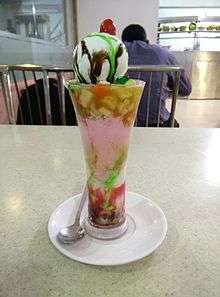Falooda
|
Faluda with kulfi, rose syrup, tapioca pearls and basil seeds | |
| Course | Beverage |
|---|---|
| Place of origin | Bangladesh |
| Region or state | Pakistan, Bangladesh, Nepal, Sri Lanka and India |
| Main ingredients | Milk, rose syrup, vermicelli, psyllium |
|
| |

Falooda (Hindi: फ़ालूदा) (Urdu: فالودہ) (Bengali: ফালুদা) (also Faluda), is a cold dessert popular in the Indian subcontinent. Traditionally it is made from mixing rose syrup, vermicelli, psyllium (ispaghol) or basil (sabza/takmaria) seeds, tapioca pearls and pieces of gelatin with milk or water.[1] Vermicelli used for preparing faloodeh is made from arrowroot whereas vermicelli used in the Indian version is usually made from wheat.[2] The present day Falooda is a result of the many variations brought by Muslim merchants settled in Medieval India of various origins present in and around the Indian subcontinent, along with variations added through native taste preferences.[3]
History
The origins of Falooda in the Indian subcontinent go back to Persia, where a similar dessert Faloodeh was popular among the Persian population. The dessert came to India with the many Muslim merchants and dynasties that settled India, and made it home.[4] Falooda, for the longest time was only made for and by Noble Muslim families in the Indian subcontinent, but today, the dessert is enjoyed by all. The present form of Falooda was developed by the Mughal empire, and spread with its many conquests. Muslim rulers who succeeded from the Mughals patronized the dessert with their own adaptations, specifically in Hyderabad Deccan and the Carnatic.[5] The ice was gathered during the winter or carried from the mountain tops and stored in large insulated underground chambers topped by dome structures, known as yakhchal. This allowed ice to remain available throughout the summer, even in the desert. The best use was made to prepare desserts like faluda. Later on, as techniques improved, rose water and sugar were added with the vermicelli. Today there are many versions of faluda. Some are made without noodles and blended with fruit. One of the Indian versions consists of kulfi, translucent wheat-starch noodles and flavoured syrup. Some faludas are served as milkshakes.
Metaphorical references
In idiomatic Hindustani, faluda is sometimes used as a reference to something that has been shredded, which is an allusion to the vermicelli noodles. For example, someone who falls into disrepute might say that his or her izzat (honour) has been turned to falooda (इज़्ज़त का फ़ालूदा, عزت کا فالودہ, izzat ka falooda), which is roughly equivalent to saying "my reputation is shot."[6]
Variants
- In India, Bangladesh, Nepal, Pakistan and Sri Lanka Falooda is often served as an ice cream sundae float. It is prepared with Psyllium seeds, boiled vermicelli, rose water and milk. It is mainly consumed after dinner.
 Faluda from a shop at Juhu Beach, Mumbai
Faluda from a shop at Juhu Beach, Mumbai - In Bangladesh, a common variant of Falooda in the south coast of the country is made with Ketaki (pandan) extract, pistachios, Shagu pearls, creamed coconut and mango as well as milk, vermicelli and may even include strong black tea to make quite a distinct flavour.
- Malaysia and Singapore have a similar drink called bandung.
- Faluda is very similar to the Thai drink nam manglak, which is made from different ingredients, such as shredded jelly, tapioca pearls, Job's Tears mixed with sugar, water, and rose water.
- The Iraqi Kurds also have their own version; but made with thicker vermicelli. A similar modern East Asian drink is bubble tea.
- A famous type of Falooda, called "Andrea", involves mixing various rose syrups with creamy milk and premature tapioca pearls.
- Rabri faluda[7]
- The Mauritian version is called alouda, which is a variation of the word falooda, and the beverage is almost identical in ingredients and flavour.
- South Africa also has a variant known by the same name,[8] and is often served as a milkshake to be consumed with or after a meal.
See also
References
- ↑ "Fall for falooda". The Hindu. 16 August 2008. Retrieved 26 January 2015.
- ↑ "Falooda". ifood.tv. Retrieved 26 January 2015.
- ↑ "The Royal Falooda | Eating India". www.eatingindia.net. Retrieved 2016-04-04.
- ↑ "Falooda". iFood.tv. Retrieved 2016-04-04.
- ↑ "The Royal Falooda | Eating India". www.eatingindia.net. Retrieved 2016-04-04.
- ↑ India today, Volume 24, Thomson Living Media India Ltd., 1999,
... Magar this time to izzat ka falooda ban jayega (my reputation will be shot) ...
- ↑ Rabdi faluda
- ↑ viii. Cape Malay Food Recipes « Cape Malays…
External links
| Wikimedia Commons has media related to Faluda. |


